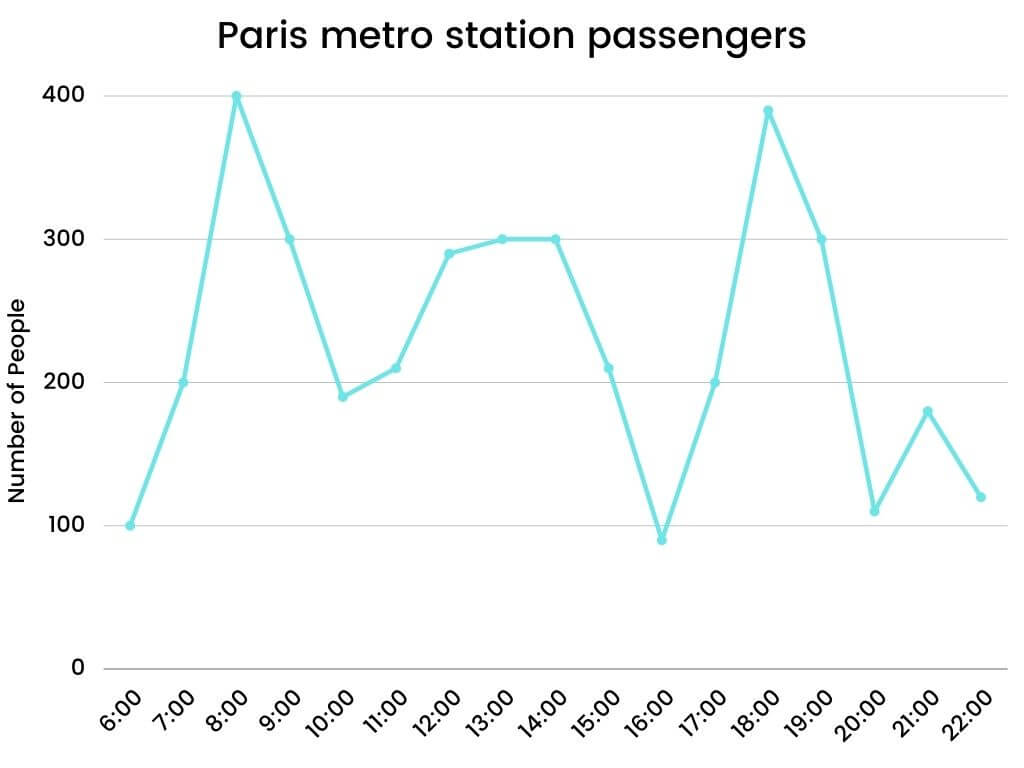محتوای الکترونیکی
Line Graph Sample

Write at least 150 words.
Report Plan
Paraphrase: show>designates; Paris Metro station passengers>number of people using a metro station in Paris
Overview: The line graph designates the number of people using a metro station in Paris over a given day of the year.
Paragraph 2: (1) Compare the statistics throughout the day. Give figures.
Paragraph 3: (1) Compare the statistics throughout the day. Give figures.
Sample Answer
The line graph designates the number of people using a metro station in Paris over a given day of the year.
The number of passengers rises sharply in the morning, reaching a peak of 400 at 8 am. After the morning peak, there is a steady drop to 300 at 9 am, and less than 200 at 10 am. Between 10-11 am, there is a small increase. The number plateaus just below 300 between 12 noon and 2 pm. There is a decline in the number of citizens using the station at 4 pm, basically standing at a number of 80 passengers. The evening brings a huge increase from 200 at 5 pm to almost 400 at 6 pm. The number of passengers tapers off slightly after 6 pm but falls quickly to 120 by 8 pm. After a small rise at 9 pm, the number tails off to 120 at 10 pm.
All in all, the time series shows that the greatest number of passengers gather in the station early in the morning and also early in the evening.
15 نظر
The number of people who use metro station in Paris over the period of 16 hours is illustrated in the given graph. Overall, the figures for metro passengers fluctuated during the given period. While in the morning (at 8) the greatest number of folks are seen in metro station, the number of citizens who travel by subway at 16 is minimum. Looking at the information in more details, it can be seen clearly that at the beginning of the day approximately 90 passengers presents in metro station. Afterward the figure sees a sharp increase before reaching at more than 400 at around 8:30. The figure seems to have experienced a rapid decrease until 18, standing at 200. Afterward, although the number of those people who use metro increases steadily, it almost remains with no change between 12 and 14. Subsequently, Before reaching the second peak (at about 18) at 400, the graph has an upward trend from 16 to 18, and the metro users becomes about 4times as many people as compared to 4 pm. Then, the figure seems to have see a fluctuation by the end of the day.
The number of people that used metro station in Paris in a day is showed by a line graph. It shows that number of people pass away through a metro station isn't constant over a day. The number of people begin with almost 100 at 6 a.m. and rises sharply and reaching a peak at 8 o'clock. Then number of passengers diminishes to 300 at 9 and reaches under 200 at 10. Until 11 it is approximately stable. There is an increase between 12 noon and 2 p.m. and number of people reaches to just below 300. In the afternoon, a sharp reduce occurs in the graph and number of passenger drops under 100. At 18, number of people again increases near the peak, but decreases quickly at close night. The graph shows the greatest use of metro happens in the morning and evening.
the shown line graph gives data on the number of people using a metro station in Paris. According to the chart, from 6 to 8 in the morning, the number of people using the metro has a significant an upward trend, which reaches its highest number by 8 in the morning.
the presented line graph shows data on the number of people who use metro station in Paris in the period from 6 am to 10 pm.
overall, the figures for metro passengers fluctuated during the given period.the highest number of passengers who have used the metro belongs to at 8:00 am and 6:00 pm and the lowest number of folks belongs to 4:00 pm.
It is evident that, the number of people using a Metro station in Paris during a day had rapid oscillations. At a glance, this index had arrived in peak rate of its in two time such as 7AM to 9AM and 17 to 19 at evening. while, there is a dramatic decline in the number of passenger ar 16 evening less than 100 person .
The line graph is of passengers in a metro station in Paris. It depicts the number and statistics for one whole day of the year. The number of people stays at 100 at 6 A.M. in the morning but suddenly rises to 400 at 8 A.M. After 8 A.M., the number drops to 300 at 9 A.M and then below 200 at 10 A.M. We do not see much change at 11 A.M. as it stays just above 200.However, at 12 A.M, the number of people again increases and reaches 300. It stays similar for the next 2 hours till 2 P.M. At 3 P.M, the number of people again comes down to 300 and under 100 at 4 P.M. Hence, we can notice a drop in the passengers after 12 P.M. till 4 P.M. After 4 P.M. the number gradually increases to 200 at 5 P.M. and 400 at 6 P.M. The number of passengers reaches its peak at 6 P.M. It slowly starts to fall again making 300 at 7 P.M. and 100 at 8 P.M. At 9 P.M. the number increases a bit making the graph stay just below 200 and at 10 P.M. it again falls to 100.
The line graph depicts the number of people who travelled from Paris Metro station from 6 AM till 10PM. A glance at the line chart reveals that, the number of people using Metro has a significant upward trend in two rush hour times at 8 in the morning and 6 in the evening. The number of passengers starts at 100 in early morning then, rocket to 400 at the 8 AM. The proportion of passengers slips back by just over 200. Between 10 AM to 2PM, apart from more or less fluctuations, number of travelers climbs from 200 to 300. After 2PM, there is a dramatic decrease to slightly less than 100. Just at 4 PM, this proportion sours and reaches a peak of nearly 400, after that plummet dramatically a little over 100. In two hours of the end of day, apart from small rise, the number drops to 120 at 10 PM.
The given line graph presents information about the number of people using a metro station in pairs over a given day of the year. as is observed, the number of passengers rocked sharply in the morning, reaching a peak of 400 at 8 am. after the morning peak, the usage of the metro station saw a dramatic reduction until 10 am. After that it increased slightly to 300 at 2 pm then there is a sharp decline until 4 pm. after this decrease there is a dramatic rise and it goes up near the peak at 6 pm. since 6 pm we see a decreasing trend until 10 pm.
The given line graph presents information about numbers of people who travel by metro station in Paris from 6 AM till 10 PM . It is obvious that the number of people pass away through a metro station has rapid fluctuation.The highest number of passengers who have used the metro belongs at 8:00 AM and 6:00 PM and the lowest number of population belongs to 4:00 pm
The provided diagram shows data on number of people using a metro station in Paris over a given day of the year. Overall, The number of passengers has increased sharply during the morning and we also see a sudden decrease and stabilization of the number of passengers at the beginning of noon. On the other hand, It is evident that the number of passengers increased significantly and suddenly from the beginning of the evening to the night.
The presented line graph designates the number of people using a metro station in Paris during the period of time of the year.as is observed, the number of passengers fluctuate swiftly between the time 6:00 in the morning and 22:00 at night.
The given graph shows information the number of people use metro station in the period from 6 am to 10 pm, in Paris. As is observed, the highest number has used the metro at 8:00 am to 6:00 pm and the lowest number at 4:00 pm, despite fluctuations.
The Paris metro transportation system costumers have been depicted in the provided chart.
The presented picture depicts the number of passenger that used metro during the day in the capital of France
لطفا وارد شوید و نظر خود را ثبت نمایید.
بهترین ها
| نام | تعداد آزمون | میزان موفقیت | |
|---|---|---|---|
| َAmeneh Darvishzadeh | 1 | 100/00 % | |
| Mehrad Hashemi | 1 | 100/00 % | |
| مهدی حسین پور آقائی | 1 | 100/00 % | |
| Farnoush Toghiany | 21 | 98/36 % | |
| zahra namdari | 46 | 98/21 % | |
| یاسمن محمدی پور | 4 | 98/08 % | |
| Sheida Taheri | 3 | 97/37 % | |
| پژمان همدانی | 3 | 97/37 % | |
| محمدحسین میرزایی | 3 | 97/30 % | |
| Tara Mohammadi | 3 | 96/43 % | |
| yasaman mohamadipur | 51 | 95/86 % | |
| محمدجواد ملائی اردستانی | 3 | 94/44 % | |
| Arzhang Saberi | 4 | 93/33 % | |
| Soheila Karimi | 124 | 92/73 % | |
| aram farhmand | 10 | 92/31 % | |
| یاشار اسکندری | 98 | 91/14 % | |
| الشان مقیمی آذر | 11 | 90/80 % | |
| عباس پورمیدانی | 1 | 90/00 % | |
| پریسا سلوکی شهرضایی | 72 | 89/49 % | |
| ارشیا قلمکاری | 33 | 89/23 % |






